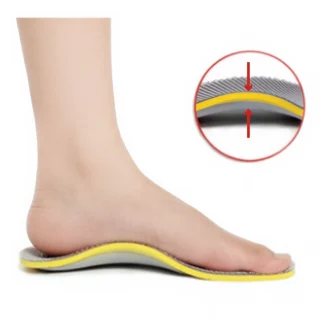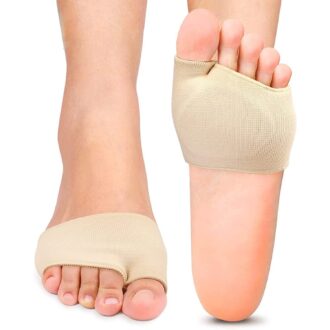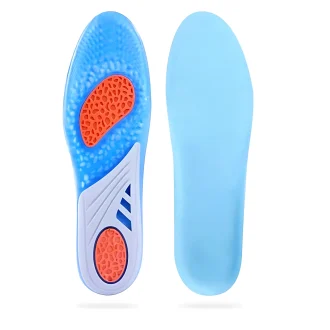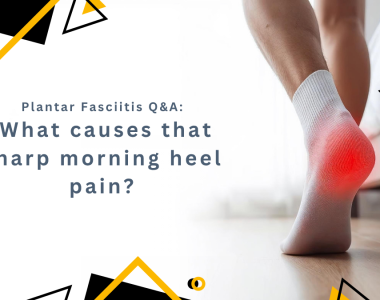No products in the cart.
Why do I feel like I have a fold or lump in my sock when there’s nothing there?
Welcome to our latest Q&A blog series, where we delve into the curious questions our customers bring to us. In this installment, we’re exploring a peculiar foot sensation that one of our customers is experiencing—a feeling of a fold or lump in the sock, even when there’s nothing there. This sensation is more common than you might think and can be puzzling to those who experience it. Join us as we uncover potential causes behind this sensation, from nerve-related factors to simple home remedies, and provide guidance on when it might be time to seek professional advice. Whether you’re dealing with this unusual feeling yourself or simply curious, read on to learn more about this unusual phenomenon.
Here is a question from one of our customers we recently had:
“Hi there, I’ve been experiencing a strange sensation in my right foot for the past couple of weeks. It feels like there’s a fold or lump in my sock, even when I’m barefoot or wearing different footwear. I haven’t had any recent injuries, and my socks and shoes fit just fine. The sensation isn’t painful, but it is quite annoying and persistent, especially when I’m walking or standing for long periods at work. Could this be related to nerve compression or something else? I’m trying to figure out if it’s worth seeing a doctor about or if there are any simple remedies I could try at home first. Any insights or suggestions from your team would be greatly appreciated. Thank you!”
Understanding This Strange Foot Sensation
If you’ve been experiencing a peculiar sensation in your foot that feels like a lump or a fold in your sock, even when there’s nothing there, you might be dealing with Morton’s Neuroma, a common condition that often causes these mysterious foot sensations, particularly between the third and fourth toes. Don’t worry—let’s dive into what this means and explore some remedies that could bring you relief!
What is Morton’s Neuroma?
Morton’s Neuroma is a condition that affects the nerves between the third and fourth toes. It occurs when the tissue around these nerves thickens due to compression and irritation. While Morton’s Neuroma is known for causing sharp, burning pain in the ball of the foot, it can also lead to sensations like tingling or numbness in the toes, or the feeling of standing on a pebble or having a fold in your sock. This discomfort stems from the thickening of the intermetatarsal plantar nerve, which leads to inflammation and fibrosis, ultimately disrupting normal nerve function.
This condition affects an estimated 10 to 20 individuals per 100,000 annually and is particularly prevalent among women in the UK, often attributed to footwear choices like high heels. Factors such as wearing tight or high-heeled shoes, engaging in activities that exert pressure on the feet, and having foot deformities like bunions or flat feet increase the risk. Middle-aged individuals and athletes who frequently stress their feet are also more susceptible.
Morton’s Neuroma can lead to chronic pain and permanent nerve damage if left untreated. This condition can significantly impact an individual’s quality of life by limiting their ability to walk or stand for prolonged periods. The resulting pain and discomfort can alter gait, leading to further issues within the kinetic chain and potentially causing problems in other areas such as the knees, hips, or back. Therefore, early diagnosis and treatment are crucial for a good prognosis. Diagnosis typically involves a physical examination, imaging tests such as ultrasound or MRI, and sometimes a diagnostic injection. Addressing the condition early on can prevent long-term complications and maintain overall mobility and quality of life.
Understanding Morton’s Neuroma is crucial for managing the condition effectively. If you experience symptoms, it’s essential to seek medical advice promptly. Remember, proactive management can significantly enhance your quality of life. If you’re dealing with foot pain, consider consulting a healthcare professional for personalized advice.
Other Possible Causes
While Morton’s Neuroma is a common cause, there are other potential causes to consider:
- Metatarsalgia: This involves general pain and swelling in the ball of the foot.
- Bursitis: This is the inflammation of the fluid-filled sacs that cushion the bones in your feet.
- Stress Fractures: These are tiny cracks that can develop in the bones of your foot.
- Tendonitis: This condition involves inflammation of the tendons in the foot, which can cause discomfort and make it feel like there’s a lump or fold in your sock.
Each of these conditions has its own set of symptoms and implications, but if your primary concern is that peculiar lump-like feeling without actual pain, Morton’s Neuroma is the strongest contender.
Potential Remedies
Before rushing off to see a doctor, there are a few simple at-home remedies you might consider:
- Orthotic Gel Insoles: These can provide additional cushioning and support to alleviate pressure on the affected nerve. By evenly distributing foot pressure, they help reduce the irritation that contributes to the sensation.
- Morton’s Pads: Specifically designed to relieve pressure on the ball of the foot, these pads can be a game-changer. They realign the foot’s position, which can help in mitigating the irritating sensation.
- Footwear Adjustments: Consider shoes with a wider toe box to reduce compression on your foot’s nerves.
- Foot Rollers: Using a foot roller to massage the ball of the foot can significantly help in relieving tension and improving blood circulation. The gentle rolling motion helps to stretch and soothe the muscles, reducing discomfort and promoting relaxation.
- Stretching Exercises: Regularly stretching your feet and toes can improve flexibility and reduce tightness in the muscles around the affected area. Simple exercises like toe curls, toe spreads, and calf stretches can enhance mobility and alleviate pressure on the nerves.
- Ice Therapy: Applying ice packs to the affected area can reduce inflammation and numb the pain. Wrap ice in a cloth and apply it to the foot for 10-15 minutes, several times a day, to help manage discomfort.
- Epsom Salt Soak: Soaking your feet in warm water with Epsom salt can have a soothing effect, reducing swelling and easing muscle tension. It also provides a relaxing experience that can help alleviate stress on the nerves.
- Foot Elevation: Elevating your feet when resting can help reduce swelling and improve circulation. Try to keep your feet raised above your heart level for optimal results.
Remember, while these remedies can provide relief, it’s essential to monitor your symptoms and consult a healthcare professional if the pain persists or worsens.
Why Choose Products from NuovaHealth?
When it comes to specialized foot care products, NuovaHealth stands out… and here’s why:
- Quality and Innovation: Our products are crafted using cutting-edge technology and superior materials, ensuring both comfort and durability.
- Expert Design: Each insole and pad is designed in consultation with podiatry experts, reflecting a deep understanding of foot anatomy and mechanics.
- Customer Satisfaction: We prioritize your comfort and satisfaction, with a commitment to helping you achieve the best results possible.
Our products are tested for efficacy and reliability, making us a trusted choice for those seeking comfort and relief. Here are a few from our collection that might help you:
-
Product on sale
 Arch Support Insoles for Plantar Fasciitis and Flat Feet£9.99
Arch Support Insoles for Plantar Fasciitis and Flat Feet£9.99£11.99inc VAT -
 Foot Massager Roller£9.99inc VAT
Foot Massager Roller£9.99inc VAT -
 Gel Cushion Metatarsal Support Morton’s Neuroma Pads£10.49inc VAT
Gel Cushion Metatarsal Support Morton’s Neuroma Pads£10.49inc VAT -
 Metatarsal Pads for Women & Men – For Mortons Neuroma, Callus Skin, Blisters, Metatarsal Foot Pain, Bunion, & Forefoot Cushioning£10.49inc VAT
Metatarsal Pads for Women & Men – For Mortons Neuroma, Callus Skin, Blisters, Metatarsal Foot Pain, Bunion, & Forefoot Cushioning£10.49inc VAT -
 Morton’s Neuroma Insoles with Forefoot cushioning & Metatarsal support£10.99inc VAT
Morton’s Neuroma Insoles with Forefoot cushioning & Metatarsal support£10.99inc VAT -
 Morton’s Neuroma Pads With Gel Cushion & Metatarsal Support£10.99inc VAT
Morton’s Neuroma Pads With Gel Cushion & Metatarsal Support£10.99inc VAT
Final Thoughts
If your symptoms persist or worsen, it’s wise to consult a healthcare professional. They can provide a comprehensive assessment and tailor treatment options to your needs. But trying these simple remedies might just be the first step towards saying goodbye to that pesky foot sensation. So, are you ready to step into comfort?… Your feet will thank you!






